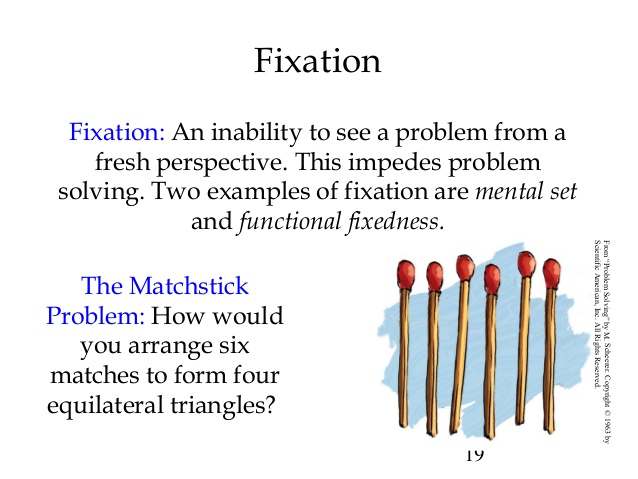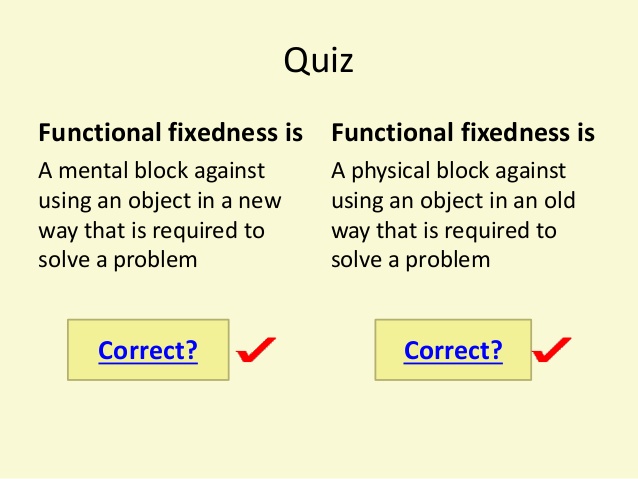Functional Fixedness
Functional fixedness is a cognitive handicap which makes us use every object in a traditional way we have seen. This prevents a novel idea cropping upon our mind. This is the most potent hurdle on the way of any problem solving activity. The day this blockage is eliminated, countless inventions could be made.

A set is Preparatory adjustment to perform a task. The practice of solving a problem in a given way tends to give people a set. They use the same rules for other problems as well.
A set may include
-immediately preceding experiences
-long established practice
-instruction that revive old habits
Set can have both facilitatory & inhibitory effects; The hindering effects of the set can be reduced by
-reducing the number of practice trials
-separating practice & critical trials by days & weeks.
-warning the subject before the critical problem
Also Read: Consistency is the key to a Successful Business

A particular kind of set that can point thoughts in wrong direction has been called functional fixedness. It is a conceptual set whereby objects that have been used for one function tend to be viewed only serving that function, even though situation may call for the use of the use of the object in different context.
Maier’s Two String Experiment: Facilitatory effect of set
Maier’s ‘Two string Problem’ consists of two strings hanging from the roof in such a way that holding one string & the subject cannot reach the other. The subject is required to figure out a way to lie two strings together, even though when he is holding onto one string, the other is out of reach. A variety of objects are available for use in the solution of the problem, such as air, tissue paper, a pair of pliers & some paper clips.
The solution involves trying the pliers to the string & setting it in motion like a Pendulum so that it can be reached while the subject is holding onto other string. Maier presented this problem to two group of subjects. One group of subjects (experimental. group) were shown a string moving like a pendulum before the problem was given. The other group (i.e control group) were not given any such experience. The performance of the experimental group was better than the control group.



Spot on with this write-up, I actually feel this web site needs a great deal more attention. I all probably be back again to read more, thanks for the information!
Im grateful for the article post.Thanks Again. Keep writing.
Thanks again for the blog.Much thanks again. Really Great.
I was suggested this web site by my cousin. I am not sure whether this post is written by him as no one else know such detailed about my problem. You are incredible! Thanks!
I used to be able to find good info from your blog posts.
It as not that I want to replicate your website, but I really like the pattern. Could you tell me which design are you using? Or was it tailor made?
What as up, just wanted to tell you, I liked this blog post. It was funny. Keep on posting!
value. But, with the increased revenue will come the
I value the blog.Really looking forward to read more. Much obliged.
Sites we recommend Excellent blog here! Also your website loads up fast! What web host are you using? Can I get your affiliate link to your host? I wish my site loaded up as quickly as yours lol
Thanks for sharing, this is a fantastic article.Thanks Again. Awesome.
Thanks-a-mundo for the blog article.Really thank you! Will read on
Very good blog post.Thanks Again. Really Cool.
Major thanks for the article post. Keep writing.
You made some good points there. I did a search on the subject and found most persons will approve with your blog.